ZY-1-02C (ZiYuan-1 Number 2 Optical Mission of China)
EO
Mission complete
Imaging multi-spectral radiometers (vis/IR)
High resolution optical imagers
Quick facts
Overview
| Mission type | EO |
| Agency | CRESDA |
| Mission status | Mission complete |
| Launch date | 22 Dec 2011 |
| End of life date | 31 Dec 2018 |
| Measurement domain | Land |
| Measurement category | Multi-purpose imagery (land), Landscape topography |
| Measurement detailed | Land surface imagery, Land surface topography |
| Instruments | CCD (ZY Series), PAN (ZY Series) |
| Instrument type | Imaging multi-spectral radiometers (vis/IR), High resolution optical imagers |
| CEOS EO Handbook | See ZY-1-02C (ZiYuan-1 Number 2 Optical Mission of China) summary |
ZY-1-02C (ZiYuan-1 Number 2 Optical Mission of China)
Overview Spacecraft Launch Mission Status Sensor Complement References
ZY-1-02C is the first high-resolution imaging mission of CNSA (China National Space Administration). Ziyuan 1-02C was the third satellite in the CBERS-2 series, but was developed as a Chinese only project with no Brazilian participation.
The satellite is China's first operational civilian remote-sensing satellite, specifically designed for the Chinese Ministry of Land and Resources (MLR). It is also the first of a series of Earth-observation satellites to be launched in the Chinese government's Planning for the Application and Development of Land and Sea Observation Satellites.
The primary objective is to acquire high-resolution panchromatic and multispectral imagery for land resource surveys,disaster monitoring, forestry and ecological monitoring.
Spacecraft
The ZY-1-02C spacecraft built by CAST (Chinese Academy of Space Technology) and funded by MRL to satisfy the urgent demand of land remote sensing data.
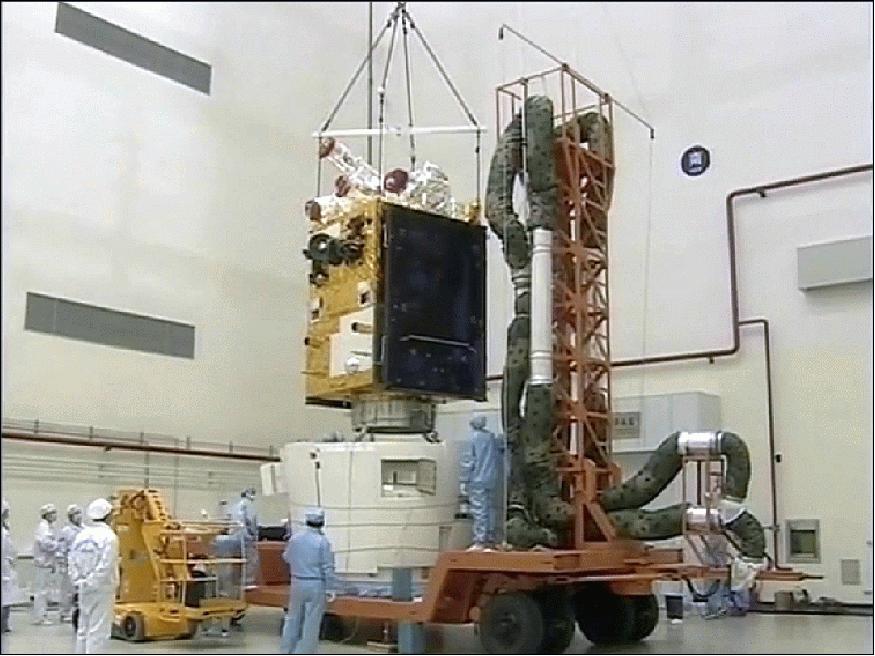
The mass of the satellite is 2100 kg, the power generation capability is 2.4 kW, and the design life is 3 years.
The spacecraft description will be updated when the information becomes available.
Launch
The ZY 1-02C spacecraft was launched on Dec. 22, 2011 from the Taiyuan Space Center on a Long March 4B vehicle. 1)
Orbit: Sun-synchronous near circular orbit, altitude = 781 km, inclination = 98.5º, period = 100.3 minutes.
Mission Status
• According to "The CEOS Database" of CEOS and ESA (updated for 2016), the ZY-1-02C mission is operational in 2016. 2)
• The ZY-1-02C spacecraft and its payload are operating nominally in 2013 and 2014. 3)

• In early March 2012, China's first high-resolution remote sensing satellite ZY-1-02C has carried out on-orbit tests. 4)
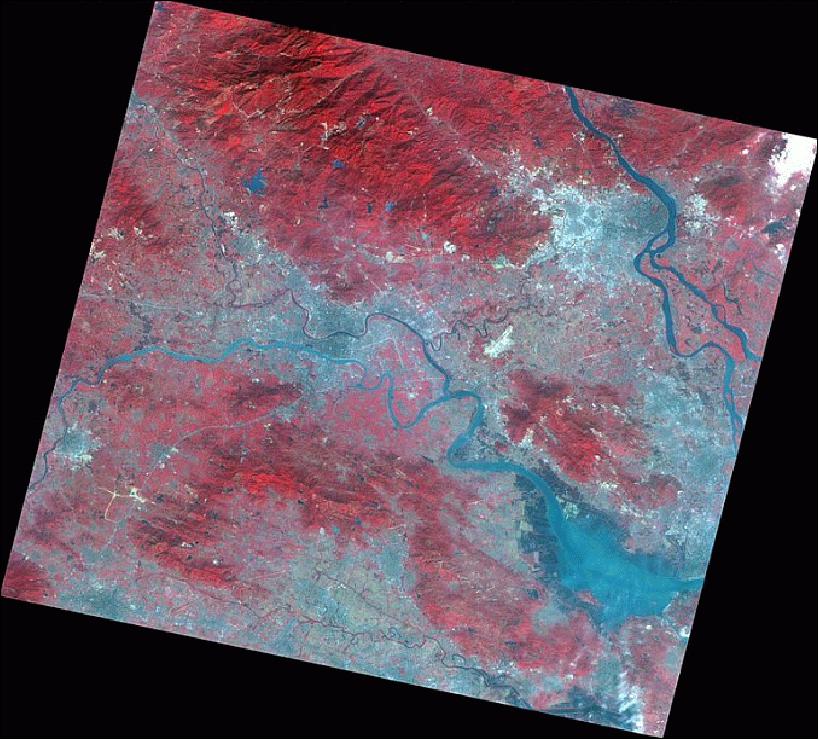
Sensor Complement
PMS (Panchromatic/Multispectral) Camera
The PMS camera is the next generation high-resolution imager designed and developed at BISME (Beijing Institute of Space Mechanics & Electricity). PMS is of CCD camera heritage, flown on the CBERS-1/-2/-02B satellite (China Brazil Earth Resources Satellite) series. The CCD camera featured a Pan + 4 MS (MUltispectral) bands with a GSD of 20 m.
The PMS camera is a linear pushbroom imager. It has a panchromatic band and three MS bands, providing a GSD (Ground Sample Distance) of 5 m in Pan and 10 m in the MS bands from an orbit of 780 km. 5)
Panchromatic band | B1: 0.51~0.85 µm |
MS (Multispectral) bands | B2: 0.52~0.59 µm |
GSD (Ground Sample Distance) | Pan: 5 m at nadir |
Swath width | 60 km |
Cross-track observation capability | ±32º |
Mass of the PMS camera | 218 kg |
Instrument design: The pushbroom camera features a catadioptric wide field telescope imaging simultaneously all the points of a line onto the monolithic CCD array located in focal plane. An image scene is created due to the forward motion of the spacecraft. The focal plane of the camera contains of four linear detector arrays in cross-track, corresponding to the four spectral bands.
The PMS camera provides the following features:
• Image with linear pushbroom modal to get a higher SNR (Signal-to-Noise Ratio).
• Use the 12,000 pixel linear CCD with a pixel pitch of 6.5 µm.
• Enhanced Schmidt catadioptric optical system to get high performance at the 77 lp/mm at Nyquist frequency.
• The video circuit is composed of two main assemblies, the FPA (Focal Plane Assembly) ensuring the spectral separation and transforming the incoming optical signal in the electronics, and the video circuit electronics, interfacing with the FPA and the satellite.
• The focal plane is adjustable for a better image tuning.
• The instrument features a swing mirror to obtain a cross-track pointing capability of ±32º.
• A thermal control subsystem is keeping the telescope within the close temperature domain. Passive and active thermal controls are used to main the average temperature within the ±2ºC while minimizing the gradient down to 0.3ºC.
• Use of service electronics which interface with the satellite and control the camera mechanisms and its active thermal control subsystem.
Optical System Design
The optical system features a long focal length along with a small f number - providing a high image quality at the 77 lp/mm Nyquist frequency. The optical elements include: swing reflective mirror, window, 45° reflective mirror, spherical reflective mirror, lens and prism. There are two imaging channels, one for the Pan band and the other for MS bands.
Optical telescope | Selection of a catadioptric Schmidt optical system |
Focal length | 1010 mm |
Relative aperture | 3.5 |
FOV (Field of View) | ±2.2º |
Spectral bands | B1: 510 – 850 nm; B2: 520 – 590 nm; |
MTF (Modulation Transfer Function) | - 0.45 at77 lp/mm (B1 band) |
Global MTF at the Nyquist frequency | > 0.18 for B1 and B4 band, |
Band-to-band registration | <3.9 µm |
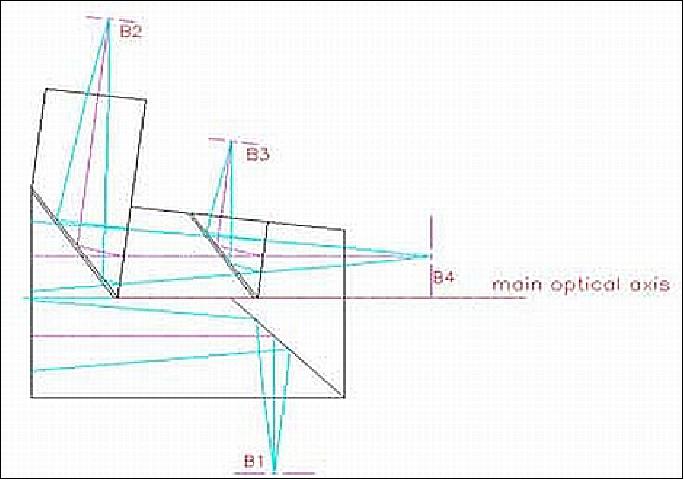
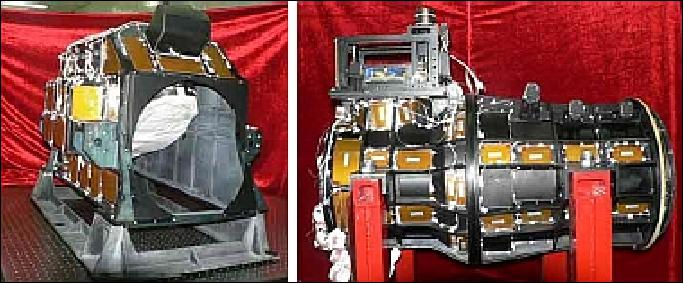
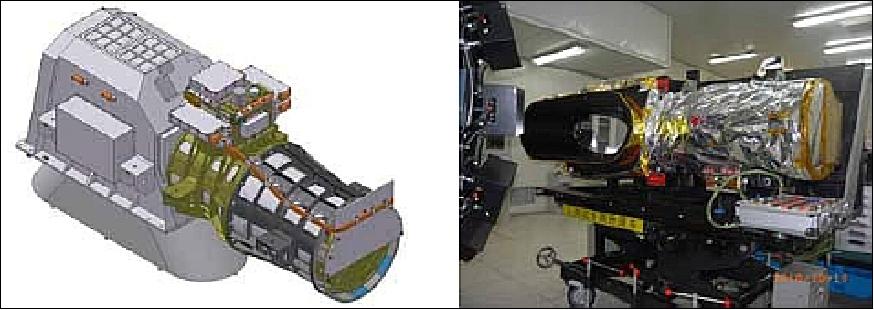
HRC (High Resolution Camera)
The HRPC provides panchromatic imagery with a GSD (Ground Sample Distance) of 2.36 m in a swath of 57 km.
As China's first satellite that is customized specifically for land resource applications, an ASDPS (Automatic Satellite Data Processing System) was established on land to ensure its commercial operation. In accordance with the ASDPS design, the Pan and MS images captured from the same area are geometrically corrected first, and then image fusion processing is performed to obtain color infrared images with higher resolution. 6)
References
1) Stephen Clark, "Final Chinese launch tally surpasses U.S. rocket fleet," Spaceflight Now, Dec. 22, 2011, URL: http://www.spaceflightnow.com/news/n1112/22longmarch/
2) "The CEOS Database," Updated for 2016, URL: http://database.eohandbook.com/database/missionsummary.aspx?missionID=731
3) Mingquan Wu, Jie Wang, Ni Yao, Zhongwei Hou, Changyao Wang, "Data Quality Evaluation of ZY-1 02C Satellite," D. Li and Y. Chen (Eds.): CCTA (Computer and Computing Technologies in Agriculture), 2012, Part II, 6th IFIP Working Group , Zhangjiajie, China, October 19-21, 2012, AICT (Advances in Information and Communication Technology) 393, pp. 187–195, Springer 2013, URL: https://link.springer.com/chapter/10.1007/978-3-642-36137-1_23
4) "China's advanced remote sensing satellite operating soundly," Space Daily, March 2, 2012, URL: http://www.spacedaily.com/reports/China_advanced_remote_sensing_satellite_operating_soundly_999.html
5) Weigang Wang, Jun Wang, Liyan Lan, Haibin Jiang, Ronghui Zhang, Chunyu Wang, "PMS Camera For ZY-1( 02C) Satellite," Proceedings of the ICSO (International Conference on Space Optics), Ajaccio, Corse, France, Oct. 9-12, 2012, paper: ICSO-041, URL: http://www.congrexprojects.com/custom/icso/2012/papers/FP_ICSO-041.pdf
6) Qi Chen, Shugen Wang, Bo Wang, Mingwei Sun, "Automatic Registration Method for Fusion of ZY-1-02C Satellite Images," Remote Sensing, Vol. 6, 2014, pp. 157-179, doi:10.3390/rs6010157, URL: http://www.mdpi.com/2072-4292/6/1/157/pdf
The information compiled and edited in this article was provided by Herbert J. Kramer from his documentation of: "Observation of the Earth and Its Environment: Survey of Missions and Sensors" (Springer Verlag) as well as many other sources after the publication of the 4th edition in 2002. - Comments and corrections to this article are always welcome for further updates (eoportal@symbios.space).
Overview Spacecraft Launch Mission Status Sensor Complement References Back to top